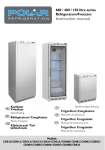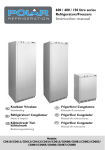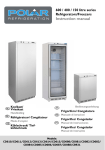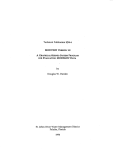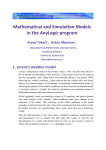Download G.3 CBL User's Manual CBLv2 is the Cebeci Boundary Layer
Transcript
report typos and errors to W.H. Mason Appendix G: Programs G-13 G.3 CBL User’s Manual CBLv2 is the Cebeci Boundary Layer Program. The program computes the two-dimensional compressible laminar and/or turbulent boundary layer. This code is described (with a listing) in the reference. Dr. Tuncer Cebeci (Dept. of Aerospace Engineering, California State University Long Beach) makes it available for $50. The current version has been modified slightly, and the output has been redesigned for WATFOR to limit output to 80 columns. The code uses the Keller Box Scheme to obtain efficient solutions to the compressible boundary layer equations. It uses the Cebeci-Smith turbulence model, an algebraic eddy viscosity model, and can handle heat transfer cases. Some compilers will require the use of SAVE statements in each routine. The program will prompt you for the name of the input file. The output is written to the screen in the version provided. This is not an interactive code and the output can be redirected to a file once the input file is defined. Note that the boundary layer is computed at each input x station, and no others. Make sure your input is closely spaced where details are important. The boundary layer computation should start at the stagnation point, and follow the flow along the upper or lower surface toward the trailing edge. This requires identifying the stagnation point in the inviscid solution and using the geometry points x,y at each solution station to compute the arc length along the surface from the stagnation point, which is the surface length X in the boundary layer calculation. The utility program POSTp can be used to convert the output file generated by PANELv2 to a form easily modified to use as input to CBLv2. Reference Tuncer Cebeci and Peter Bradshaw, Physical and Computational Aspects of Convective Heat Transfer, Springer-Verlag, Berlin, 1984. Note: This program is representative of standard programs used in industry. Experience by students indicates that successful use of this program requires more patience than some students are willing to use. It is very important to put the data in the proper column. When the program is near separation the numerical iteration sometimes breaks down and the program stops with an error message. This does not necessarily mean that the solution is invalid at previous steps. When the pressure is specified, the boundary layer equations are singular at separation, and any Monday, January 27, 1997 G-14 Applied Computational Aerodynamics numerical iteration will diverge. The program attempts to identify this situation and stop with a message suggesting that separation has been encountered. Sometimes the solution blows up before the code message is printed. One of the most important input parameters is the initial dimensionaless pressure gradient. The values of the pressure gradient should be examined to make sure that the distribution is smooth. The code interpolates the user specified pressures to get the pressure gradient using a second order polynomial which can poor estimates of the gradient if the input data is not smooth. INPUT FORMAT Card 1: A80: - Data set title Card 2: 2I3, 3F10.5 NXT NTR P2(1) - total number of x stations input (60 max) - transition location station (must be > 2) x dUe Ue dx Note: for zero pressure gradient case, P2(1) is zero, for flow that starts at a stagnation point, the local stagnation point solution assumes that the velocity - dimensionless pressure gradient at 1st x station, increases linearly from zero, and the value of this parameter should be one. [good values of DETA(1), VGP: Laminar Turbulent & Lam/Turb] DETA(1) - h1, wall grid spacing: 0.2 0.01 VGP - K, ratio of spacings 1.0 1.14 Card 3: 7F10.5 RMI T0 XLL RELM PR - freestream Mach number - freestream stagnation temperature (deg. K) - reference length, L - Reynolds number per unit length, in millions - Prandtl number (.72 for air) ALFA0 ALFA1 heat transfer control codes [values of alpha0,alpha1], for specified: wall temp heat transfer] - alpha0: 1 0 - alpha1: 0 1 Card 4: 3F10.5, repeat card 4 NXT times X(I) CP(I) WW(I) - x/L nondimensional distance along surface - pressure coefficient - dimensionless wall temp, gw, or the heat flux given by the dimensionless wall temperature gradient of pw (depending on ALFA0, and ALFA1 values). Monday, January 27, 1997 report typos and errors to W.H. Mason Appendix G: Programs G-15 Example of cblv2.f input (cblv2ref.inp on the disk) upper surf. Cps from GA(W)-1 at M = .15 and 2 deg AOA 43 9 1.000 0.01 1.14 .150 200.00 1.000 6.0 .72 0.0 0.000000 1.005642 0.000000 0.004614 0.936635 0.000000 0.013224 0.549866 0.000000 0.024531 -0.084785 0.000000 0.036161 -0.708135 0.000000 0.048151 -1.025962 0.000000 0.061727 -1.198553 0.000000 0.077307 -1.272074 0.000000 0.094830 -1.240493 0.000000 0.114472 -1.187699 0.000000 0.136324 -1.137414 0.000000 0.160324 -1.082872 0.000000 0.186394 -1.042838 0.000000 0.214456 -1.010707 0.000000 0.244340 -0.977603 0.000000 0.275907 -0.950920 0.000000 0.308993 -0.927588 0.000000 0.343418 -0.908177 0.000000 0.378998 -0.891323 0.000000 0.415537 -0.873235 0.000000 0.452835 -0.857548 0.000000 0.490691 -0.845519 0.000000 0.528899 -0.831693 0.000000 0.567257 -0.813231 0.000000 0.605569 -0.785736 0.000000 0.643650 -0.732378 0.000000 0.681338 -0.660691 0.000000 0.718408 -0.579180 0.000000 0.754647 -0.493191 0.000000 0.789814 -0.408020 0.000000 0.823666 -0.331905 0.000000 0.855952 -0.257680 0.000000 0.886487 -0.187632 0.000000 0.915043 -0.124057 0.000000 0.941433 -0.067627 0.000000 0.965482 -0.019300 0.000000 0.987046 0.023179 0.000000 1.006006 0.062768 0.000000 1.022249 0.096355 0.000000 1.035669 0.123776 0.000000 1.046187 0.162320 0.000000 1.053742 0.228643 0.000000 1.058293 0.319797 0.000000 Monday, January 27, 1997 1.0 G-16 Applied Computational Aerodynamics Description of Output The output corresponding to the sample input is in the file cblv2ref.out on the disk. First, the input is echoed, [P2(1) is given with the distribution of values with X(I)]. After the Mach number is repeated, the computed reference temperature, static pressure, velocity, density, total enthalpy and pressure in atmospheres are output. The edge velocity distribution, converted using the input pressure coefficient distribution, is output together with other computed values in two sets to meet the 80 column output limitation. The first set is: X(I) UE(I) WW(I) TE(I) RHOE(I) - distance along surface, in physical units - edge velocity in meters/sec. - dimensionless temperature or temperature gradient input - edge static temperature - edge density The second output set is: X(I) RMUE P1 - distance along surface, in physical units - edge viscosity - edge parameter 1 x d (ρeµ e) 1+ P2 + 2 ρeµ e dx P2 - edge parameter x dUe Ue dx The computations are then output one station at a time, first giving the station number, the X value of the station, and the convergence history (IT is the iteration count, and is reset if an extra grid point is added during the calculation). After convergence, the profiles at each station are given at every third grid point in two sets. The first set is: J ETA Y F U V - grid line index computational normal coordinate physical coordinate transformed streamfunction U/Ue = F' U' the gradient of the velocity distribution - grid line index computational normal coordinate physical coordinate H/He G' the gradient of the enthalpy distribution effective viscosity distribution, C[1 + ε m+ ] The second set is: J ETA Y G O B Monday, January 27, 1997 report typos and errors to W.H. Mason Appendix G: Programs G-17 and then the rest of the parameters of interest are given: RX DELS THETA - NUSSELT NO - H CF/2 RDELS RTHETA - STANTON NO - local running length Reynolds number displacement thickness momentum thickness q˙w x Nux = ( Tw − Te) k shape factor, DELS/THETA skin friction Reynolds number based on displacement thickness Reynolds number based on momentum thickness q˙ w St x = ρ eue( Hw − He ) At the finish of the calculation the distributions of the computed quantities given above are repeated in two sets in summary form. The first set is: X RX DELS THETA H CF/2 X RDELS RTHETA NUSSELT NO STANTON NO. The second set is: It is likely that separation will occur. When this happens the programs halts. When possible, separation is flagged in the output, and the summary of results up to separation are printed out in the summary. Monday, January 27, 1997





